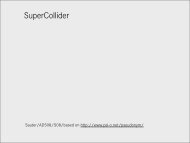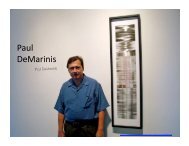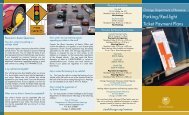the coming age of calm technology[1] - Daniel Sauter
the coming age of calm technology[1] - Daniel Sauter
the coming age of calm technology[1] - Daniel Sauter
- No tags were found...
You also want an ePaper? Increase the reach of your titles
YUMPU automatically turns print PDFs into web optimized ePapers that Google loves.
Bits flowing through <strong>the</strong> wires <strong>of</strong> a computer network are invisible...http://www.ubiq.com/hypertext/weiser/acmfuture2endnote.htmyou when you use it, is a personal computer. Most handheld computers, such as <strong>the</strong> Zaurus, <strong>the</strong>Newton, or <strong>the</strong> Pilot, are today still used as personal computers. A $500 network computer is still apersonal computer.TRANSITION - THE INTERNET AND DISTRIBUTEDCOMPUTINGA lot has been written about <strong>the</strong> Internet and where it is leading. We will say only a little. TheInternet is deeply influencing <strong>the</strong> business and practice <strong>of</strong> <strong>technology</strong>. Millions <strong>of</strong> new people and<strong>the</strong>ir information have become interconnected. Late at night, around 6am while falling asleep aftertwenty hours at <strong>the</strong> keyboard, <strong>the</strong> sensitive technologist can sometimes hear those 35 million webp<strong>age</strong>s, 300 thousand hosts, and 90 million users shouting "pay attention to me!"Interestingly, <strong>the</strong> Internet brings toge<strong>the</strong>r elements <strong>of</strong> <strong>the</strong> mainframe era and <strong>the</strong> PC era. It isclient-server computing on a massive scale, with web clients <strong>the</strong> PCs and web servers <strong>the</strong>mainframes (without <strong>the</strong> MIS department in charge). Although transitional, <strong>the</strong> Internet is a massivephenomena that calls to our best inventors, our most innovative financiers, and our largestmultinational corporations. Over <strong>the</strong> next decade <strong>the</strong> results <strong>of</strong> <strong>the</strong> massive interconnection <strong>of</strong>personal, business, and government information will create a new field, a new medium, againstwhich <strong>the</strong> next great relationship will emerge.PHASE III - THE UC ERAThe third wave <strong>of</strong> computing is that <strong>of</strong> ubiquitous computing, whose cross-over point with personalcomputing will be around 2005-2020[3]. The "UC" era will have lots <strong>of</strong> computers sharing each <strong>of</strong>us. Some <strong>of</strong> <strong>the</strong>se computers will be <strong>the</strong> hundreds we may access in <strong>the</strong> course <strong>of</strong> a few minutes <strong>of</strong>Internet browsing. O<strong>the</strong>rs will be imbedded in walls, chairs, clothing, light switches, cars - ineverything. UC is fundamentally characterized by <strong>the</strong> connection <strong>of</strong> things in <strong>the</strong> world withcomputation. This will take place at a many scales, including <strong>the</strong> microscopic[4].There is much talk today about "thin clients," meaning lightweight Internet access devices costingonly a few hundred dollars. But UC will see <strong>the</strong> creation <strong>of</strong> thin servers, costing only tens <strong>of</strong> dollarsor less, that put a full Internet server into every household appliance and piece <strong>of</strong> <strong>of</strong>fice equipment.The next generation Internet protocol, IPv6[5], can address more than a thousand devices for everyatom on <strong>the</strong> earth's surface[6]. We will need <strong>the</strong>m all.The social impact <strong>of</strong> imbedded computers may be analogous to two o<strong>the</strong>r technologies that havebecome ubiquitous. The first is writing, which is found everywhere from clo<strong>the</strong>s labels to billboards.The second is electricity, which surges invisibly through <strong>the</strong> walls <strong>of</strong> every home, <strong>of</strong>fice, and car.Writing and electricity become so commonplace, so unremarkable, that we forget <strong>the</strong>ir huge impacton everyday life. So it will be with UC.Two harbingers <strong>of</strong> <strong>the</strong> <strong>coming</strong> UC era are found in <strong>the</strong> imbedded microprocessor, and <strong>the</strong> Internet. Itis easy to find 40 microprocessors in a middle class home in <strong>the</strong> U.S.A. today. They will be found in<strong>the</strong> alarm clocks, <strong>the</strong> microwave oven, <strong>the</strong> TV remote controls, <strong>the</strong> stereo and TV system, <strong>the</strong> kid'stoys, etc. These do not yet qualify as UC for two reasons: <strong>the</strong>y are mostly used one at a time, and<strong>the</strong>y are still masquerading as old-style devices like toasters and clocks. But network <strong>the</strong>m toge<strong>the</strong>rand <strong>the</strong>y are an enabling <strong>technology</strong> for UC. Tie <strong>the</strong>m to <strong>the</strong> Internet, and now you have connectedtoge<strong>the</strong>r millions <strong>of</strong> information sources with hundreds <strong>of</strong> information delivery systems in yourhouse. Clocks that find out <strong>the</strong> correct time after a power failure, microwave ovens that downloadnew recipes, kids toys that are ever refreshed with new s<strong>of</strong>tware and vocabularies, paint that cleans<strong>of</strong>f dust and notifies you <strong>of</strong> intruders, walls that selectively dampen sounds, are just a fewpossibilities.The UC will bring information <strong>technology</strong> beyond <strong>the</strong> big problems like corporate finance andschool homework, to <strong>the</strong> little annoyances like Where are <strong>the</strong> car-keys, Can I get a parking place, and2 <strong>of</strong> 7 3/3/08 12:25 PM


![the coming age of calm technology[1] - Daniel Sauter](https://img.yumpu.com/47923551/2/500x640/the-coming-age-of-calm-technology1-daniel-sauter.jpg)







